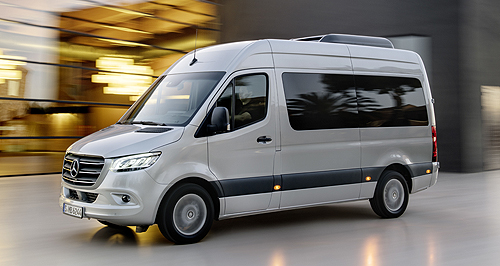Future models - Mercedes-Benz - SprinterMercedes-Benz broadens appeal in new SprinterMaster of all trades: With a choice between five diesel engines, three transmissions, three drivetrains and various body styles, Mercedes-Benz Vans aims to have a Sprinter to suit almost any application. Body, engine, drivetrain choices push new-gen Merc Sprinter van to 1734 variants7 Feb 2018 By TUNG NGUYEN in GERMANY MERCEDES-BENZ has uncovered its new-generation Sprinter van and cab-chassis range boasting front-wheel-drive variants for the first time alongside the traditional rear- and all-wheel-drive versions, all with updated technologies including the German brand’s latest MBUX infotainment system. The third-generation Sprinter – unveiled in Duisburg, Germany, overnight – will be launched in Australia in October with a choice of four- or six-cylinder diesel engines across various body styles and drivetrains with manual and automatic transmissions for a total of 1734 possible combinations. Maximum load capacity is 17 cubic metres and 5500kg. Mercedes-Benz has retained the same exterior dimensions of its most popular version – the second-generation rear-wheel-drive van that was in production for 12 years from 2006. This version is mostly the same from the outgoing version to allow for bodybuilders and bespoke body work to carry straight over. Speaking to GoAuto at the reveal event, Mercedes-Benz Vans Australia and New Zealand PR and corporate communications manager Blake Vincent said the customisation work would be easily transferable from the old Sprinter to new. “The main reason for that is when bodybuilders utilise the vehicles, they’ve already got a lot of their equipment set-up for those dimensions, so it just makes sense to keep it the same,” he said. “An example of that in Australia is Ambulance. They use our van and they build in a whole heap of equipment into the back, so all that can be transferred into the new Sprinter without a lot of rework. “There may be some adjustments required here and there, but the idea is that most equipment can be shifted in ready to go."Mr Vincent said the new Sprinter had already garnered strong interest from fleet customers around Australia in the lead up the reveal, but orders were yet to be placed. “It’s all our national fleet customers – they’ve obviously been interested because, like I said, they’ve often got a lot of set-up that goes into the vehicles, so they’ve been interested to find out things like ‘have dimensions changed’, ‘what additional features will be coming’. “We’ve had those conversions across all our customers to start to get them prepared to make the switch, and we’ll start to ramp that up now as we get closer to ordering.” Key to the appeal of the new Sprinter will be a new entry-level front-wheel-drive configuration that will underpin all short wheelbase vehicles. With a front-axle driven set-up, the Sprinter can accommodate 50kg more payload and has an 80mm lower loading edge than its rear-wheel-drive counterpart. However, Mr Vincent said the RWD Sprinter would likely remain the volume seller with the FWD version adding more versatility. “Front-wheel drive does present new opportunities, it will open new sectors to Sprinter – sectors that we’ve not been able to fully maximise before,” he said. “Motor home will definitely be a good opportunity for front-wheel drive. You are now able to build a motor home and not have to build an additional access step because the vehicle is lower. “Also, in combination with front-wheel drive, there’s the tractor head variant, and tractor head allows the motor home manufacturer to build everything basically from the B-pillar back to the specific requirement that they have. “There is a lot more flexibility for the motor home builder in that sense, so that’s a real strong point for front-wheel drive.” Powertrain options open with a 2.1-litre four-cylinder engine available in four tunes, 84kW/300Nm, 105kW/330Nm, 120kW/360Nm and 130kW/400Nm – the latter available only in camper van configuration. A carryover turbocharged 3.0-litre V6 diesel is also on offer, producing 140kW at 3800rpm and 440Nm from 1600 to 2600rpm, while an all-electric version is expected to hit the market in 2019 (see separate story). Transmission choices range from a six-speed manual, which is available as standard all four-cylinder diesels, while a seven-speed automatic is offered as option on the RWD and AWD four-pot diesels. FWD versions gain exclusive access to a new-to-the-Sprinter nine-speed torque converter automatic as an option. Diesel V6 offerings will be paired with a RWD or AWD drivetrain with a seven-speed automatic. While exterior styling has remained largely the same – the new Sprinter wears an updated front grille and sleeker headlights than its predecessor – interior improvements such as more ergonomic seats are much more visible. Mercedes-Benz’s new User Experience infotainment system will make its light-commercial vehicle debut on the Sprinter – only the second model announced to receive the new technology after the A-Class small car. Revealed during January’s Consumer Electronics Show (CES), MBUX features natural speech recognition software that allows occupants to control vehicle functions and satellite navigation information via voice commands. The system will also tie into the new Mercedes Pro connect services that allows for easier fleet management with an always-on internet connection for seamless data logging, service information and locational data. Active safety features will also be on offer in the new Sprinter including autonomous emergency braking, lane keep assist, 360-degree surround-view cameras, traffic sign recognition, adaptive cruise control and crosswind assist.  Read more6th of February 2018  MBUX roll-out imminent, voice assistants to dominateNew infotainment and Hey Mercedes integration set for entire Benz line-upSprinter pricing
Motor industry news |
Click to shareMercedes-Benz modelsResearch Mercedes-Benz Sprinter pricing
Motor industry news |












































Facebook Twitter Instagram